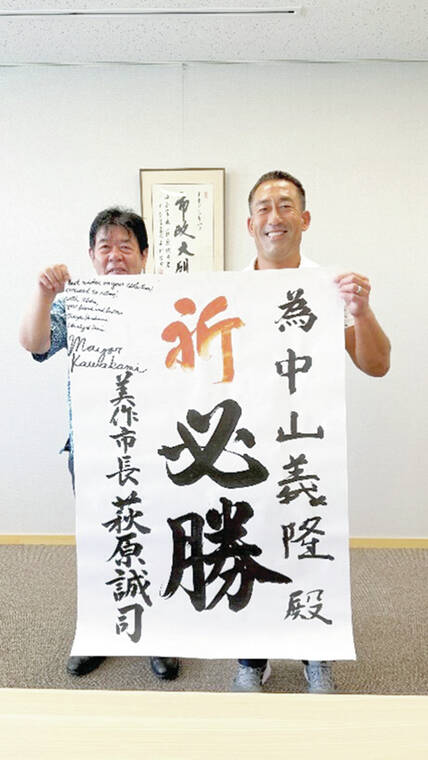LIHUE — Mayor Derek S.K. Kawakami and a delegation from Kaua‘i recently returned from a successful diplomatic and cultural exchange visit to Japan.
The visit reaffirmed Sister City relationships that span generations and opened new doors for educational, cultural, and economic collaboration between Kaua‘i and its Japanese counterparts, according to a press release.
Over the course of July 20 to 28, the Kaua‘i delegation visited the cities of Mimasaka, Moriyama, and Suo-Oshima, as well as Kyoto and several surrounding municipalities, where they engaged in ceremonial events, historical tours, cultural demonstrations, and personal exchanges that highlighted the deep bonds between Kaua‘i and Japan.
“Traveling through Japan and engaging directly with our Sister City communities was both humbling and energizing,” said Kawakami. “From the moment we arrived, the hospitality shown to us was extraordinary, and the mutual respect and connection between our people could be felt in every moment. These ties are not just symbolic—they are personal, lived, and continually evolving.”
The official itinerary began with a courtesy visit on July 21 to Mimasaka Mayor Seiji Hagiwara and city officials, setting a welcoming tone for the days ahead.
On July 22, the delegation attended a captivating kendo exhibition followed by a scenic visit to Berupiru Nature Park. That evening, Kawakami participated in a Sister City signing ceremony, marking the first official Sister City relationship established under his administration.
“This is more than a ceremonial exchange,” said Kawakami. “Our Sister City relationships reflect a shared commitment to peace, understanding, and the celebration of unique cultures. These friendships remind us that local governments have a role to play in fostering global unity.”
While previous administrations formalized several such partnerships, this marks the first Sister City created during Kawakami’s tenure. Rather than pursuing quantity, Kawakami has focused on building meaningful connections where time and energy can be invested to deepen mutual understanding and long-term cooperation.
On July 23, the group toured a preserved stretch of the historic Nakasendo trade route, followed by a traditional Japanese pastry-making demonstration. These immersive experiences allowed the delegation to appreciate the craftsmanship and stories that continue to define rural Japan.
The visit continued in Moriyama on July 24, where Kawakami was warmly received by Mayor Takafumi Morinaka. Together, they took part in a formal ceremony commemorating the 50th anniversary of the Sister City relationship between Moriyama and Kauai. Kawakami delivered remarks emphasizing the strength and longevity of this international bond.
“As we honored five decades of friendship with Moriyama, I was given the opportunity to reflect on the many people whose lives have been enriched by this relationship,” said Kawakami. “It was a powerful reminder that continuity, mutual learning, and shared values can bridge even the widest oceans. We also recognize and deeply appreciate the leaders and community members who came before us and laid the foundation for this enduring partnership.”
That afternoon, the Kaua‘i delegation toured the Ohminchi Farmers Cooperative Market and the new Moriyama City Library. The day also included a hula workshop hosted at the library and a visit to Myoren Park, renowned for its lotus blossoms.
The group later visited Lake Biwa Park and attended an official reception hosted at the Biwako Marriott Resort Hotel, bringing together local leaders, artists, and community members.
On July 25, the delegation traveled south to Suo-Oshima, one of Kaua‘i’s longest-standing Sister Cities, with a relationship spanning 63 years and historical ties dating back to the migration of Japanese laborers to Hawai‘i over a century ago.
There, the delegation was welcomed by municipal staff before joining residents at the Sata Hula Festival along the island’s oceanfront. Kawakami addressed attendees during the evening reception at the Hotel and Resort Sunshine Sazanseto.
“The hula festivals in Suo-Oshima are symbolic of the beautiful cultural exchange that continues to thrive between our islands,” said Kawakami. “Seeing residents here dance hula with such respect and joy filled me with gratitude. It speaks volumes about the way aloha has taken root far beyond our shores.”
The following day was rich with symbolic and cultural significance. The Kaua‘i delegation visited the Nagaura Green Stay Sports and Hotel facility, which includes a building modeled after Kaua‘i’s own Historic County Building in Līhu‘e.
The itinerary also included a tour of the Museum of Japanese Emigration to Hawai‘i, where Kawakami and his team reflected on the enduring impact of Japanese immigrants in shaping Hawai‘i’s social and economic fabric.
“Visiting the museum and seeing the stories of those who left Japan for Hawai‘i was deeply emotional,” said Kawakami. “These individuals laid the foundation for the generations that followed, and they remind us of the resilience and courage it takes to bridge cultures and create new communities.”
Later that day, a hula workshop for students and adults was held at the Suo-Oshima Culture Center, allowing participants to connect through shared movement and tradition. The day concluded with a heartfelt farewell dinner hosted by local restaurateur and community leader Chairman Yanai at Arakawa Restaurant.
On July 27, the group paid a final courtesy visit to Mayor Kiyotaka Fujimoto before concluding their trip with a half-day tour in Kyoto the following morning.
The delegation departed Japan on July 28, returning home with strengthened partnerships and lasting memories.
“This visit reaffirmed the values we share with our Japanese counterparts: community, family, and respect for tradition,” said Kawakami. “On behalf of the people of Kaua‘i, I offer my sincere appreciation to our hosts, and I look forward to building on these relationships in the years to come.”


AloJapan.com